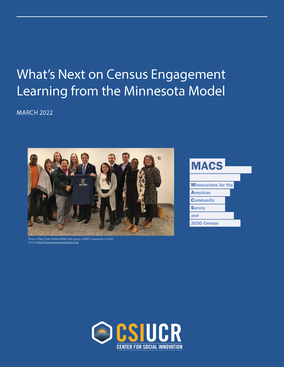Center for Social Innovation

What's Next on Census Engagement: Learning from the Minnesota Model
There are a slew of organizations at the national level organizing around the work of the U.S. Census Bureau. They work on the decennial census, American Community Survey, and other Census Bureau products—building community awareness, stakeholder engagement, and advocacy around data quality and accessibility that meet community needs.
This work is also essential at the state level, but state efforts are comparatively rare. Until recently, the only significant evergreen statewide effort on the ACS and decennial Census was MACS (Minnesotans for the American Community Survey). The all-volunteer group, founded in 2014, works to inform and educate community members, leaders, and government offices on the importance and necessity of publicly available data, including the decennial Census and ACS.
MACS employs a successful model that focused on “grass-tops' and, more recently, “grass-roots” partnerships and building a state-wide coalition that is both diverse and representative—including Minnesota leaders, policy and decision makers, business and development planners, forecasters, housing and social service providers, educators, and engaged residents. MACS was one of many partners that helped the State of Minnesota keep all eight of its Congressional seats by a very narrow margin, a Minnesota count of just 26 people. This policy victory demonstrates the importance of collective efforts that organize years in advance of the decennial census, with well–designed education and engagement strategies and partnerships with other state, local, and national organizations.
To dig deeper into the MACS model and to better understand how certain features from this model may be replicated in other states or regions, the University of California, Riverside through its Center for Social Innovation conducted a case study of MACS, to better document its origins and evolution over time. Through in-depth interviews and an analysis of secondary sources, this case study breaks down the key features of the MACS model, the key strategies that were employed, the origins and key accomplishments of MACS, and concludes with important recommendations and next steps.
